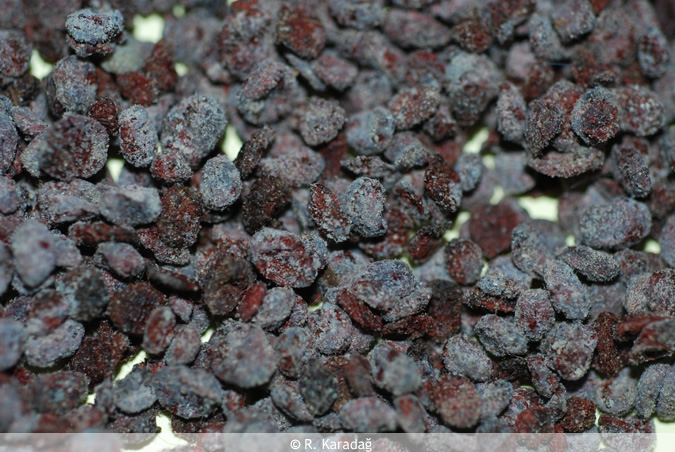This insect is native to the area of Mount Ararat inTurkish eastern Anatolia and in Armenia . This insect is a parasite on the roots of two varieties of grass: Phragmatis australis and Aeleuropus littoralis. They grow in the salt marshes on both sides of the river Aras (Araxas), which flows past the north side of Mount Ararat and forms the border between Turkey and Armenia . At a certain time in the fall, the female insects, which can be up to a centimeter long, come up to the surface. The traveller Parrot (Parrot 1834) writes in his book Trip to Ararat that the sheep that grazed in the salt marshes on the slopes of Ararat get red feet. The insects, before sunrise, crawl around on the surface of the ground and let themselves be easily gathered. An hour later, the red animals all disappear underground again. Their biology is very complicated.Ararat kermes consists of up to 50% of lipids , fatty substances. Apparently these also impede the dyeing process. On silk, we could only achieve a medium pink-red on wool, a darker red.
Historical Data
In the eighth century B.C., Sargon II, king of Assyria , defeated the Urartaean kingdom and plundered its palaces. Scarlet red textiles from Ararat are listed as booty. We can assume that these highly appreciated textiles were dyed with Ararat kermes ( Porphyrophora hameli Brand), which is referred to some literature as Armenian kermes or Ararat cochineal. The essential dye ingredient of these insects, carminic acid, has been found in Roman textiles of the first or second centuries A.D. from Palmyra .Armenian sources cited their usage in dyeing silk and for colouring at miniature painting in fifth century AD. Ararat kermes was used for the crimson coloured luxury textiles for rich people. At the same time, in Persia Sassanides produced luxurious textiles which many examples of which were preserved. Animal decorations and stylized plants on the silk textiles dyed with invaluable red of insects, kermes and Ararat kermes were produced for the rich people and a series of superb cashmere caftans belongs to 6th century, discovered in Egypt at the excavations of Albert Gayet in 1896. One of them is a fragment of crimson cashmere cloth dyed with the Ararat kermes. After the collapse of the Sassanide Empire, several Persian and Arabian authors of the Middle Ages continued to announce the kirmiz as an important production of Ararat kermes.The fabrics, carpets and cushions were famous for red dyeing: the kirmiz is especially employed in the dyeing of wool, silk, and the mohair. It was also exported in great quantities by Trebizonde to Crimea and towards the West, became an essential dye products for the western silk dyers.

